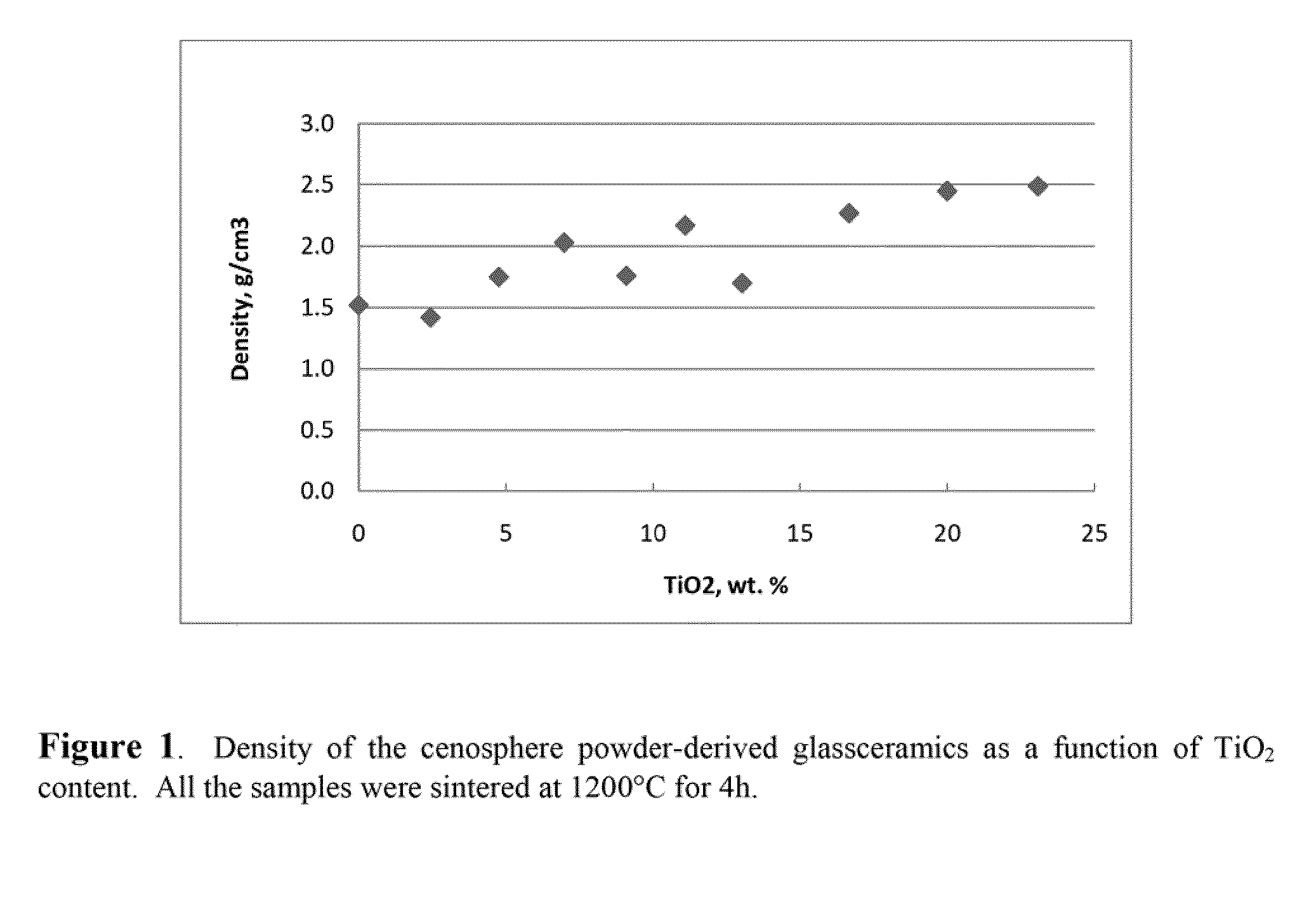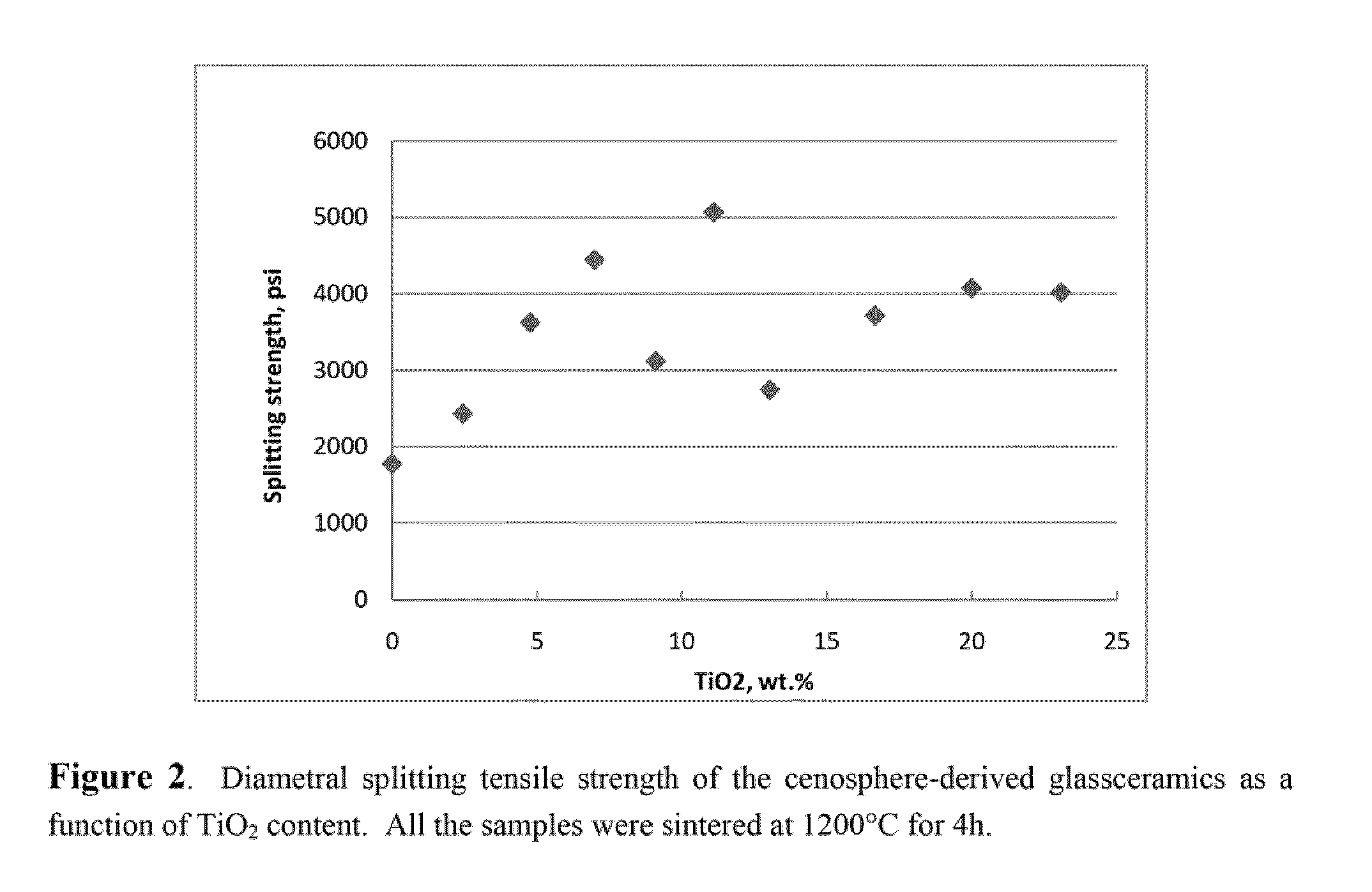Proppant having a glass-ceramic material
a technology of glass-ceramic materials and proppants, applied in the field of proppants, can solve the problems of low specific gravity of high-strength proppants, low flexural strength and stiffness, and high cost of conventional high-strength materials, and achieve the effect of increasing the rigidity module and improving the thermal expansion coefficien
- Summary
- Abstract
- Description
- Claims
- Application Information
AI Technical Summary
Benefits of technology
Problems solved by technology
Method used
Image
Examples
example 1
[0154]A proppant according to the present invention can be prepared by coating conventional glass cenospheres with alkali metals. The alkali metals can be dip-coated, spin coated, and spray-coated onto the glass cenospheres. Alternatively, the cenospheres can be doped with transitional metal oxides. Once the cenospheres are coated or doped, as described, they are subjected to heat treatment for crystallization. The cenospheres are heated to temperatures of 500° C. to 1,000° C. for a period of time sufficient to crystallize at least an outer surface of the cenospheres. The amount of time in which the cenospheres are heated can vary depending on the degree of crystallization desired. The cenospheres can be heated, for example, for a period of about 30 minutes to 12 hours, or from 2 hours to 10 hours. If full crystallization of the cenospheres is desired, the cenospheres should be heated for a fraction of an hour to several hours, for example, 0.1 to 10 hours or more.
[0155]Once the des...
example 2
[0156]
TABLE 1Chemical compositions (in wt %) of two cenosphere samples used forglass-ceramic synthesisSiO2Al2O3Fe2O3MgOCaONa2OK2OTiO2P2O5MnO62.0523.405.891.491.521.182.610.980.210.0659.2926.123.021.33.622.131.250.610.060.02
[0157]The two cenosphere samples above were each reduced to powder so as to have an average particle size of approximately 6 μm. Then, circular pellets (spheres) were made with each of the powders, wherein some of the powder mixtures had various levels of TiO2 added as shown in FIG. 1. The circular pellets were then sintered at 1200° C. for 4 h. The results are set forth in FIGS. 1-3 and Table 2. As shown, the addition of TiO2 was very effective in strength improvement. FIG. 1 shows the density as a function of TiO2 content. As can be seen in FIGS. 2 and 3, the strength of the samples increased steeply with a general increase of TiO2 content, but there is a valley at 13 wt % TiO2. The maximum strength was observed at 13 wt % TiO2. The strength was more than double...
example 3
[0159]In this example, additional proppants were prepared using the first cenosphere powder in Table 1 with cordierite. In particular, the mixture (before taking into account the amount of the TiO2 present) was composed of 25 wt % cenosphere powder and 75 wt % cordierite and this mixture was formed into spheres, with the indicated additions of TiO2, and sintered at 1260° C. for 6 h. The density and strength data of the samples are set forth in Table 3. The splitting strength of the composite increased gradually with the content of the TiO2 and reached the maximum at 7 wt % TiO2. The amount of TiO2 is based on the total weight of the pellet or sphere. The strength at this TiO2 level was more than doubled (108% net strength increase over the control) higher than the sample without any TiO2. The strength increase is mainly attributed to the glass-ceramic formation in the cenosphere powder. With the TiO2 content increase, the strength of these 1260° C. sintered composite samples increas...
PUM
| Property | Measurement | Unit |
|---|---|---|
| Krumbein sphericity | aaaaa | aaaaa |
| Krumbein sphericity | aaaaa | aaaaa |
| Krumbein sphericity | aaaaa | aaaaa |
Abstract
Description
Claims
Application Information
 Login to View More
Login to View More - R&D
- Intellectual Property
- Life Sciences
- Materials
- Tech Scout
- Unparalleled Data Quality
- Higher Quality Content
- 60% Fewer Hallucinations
Browse by: Latest US Patents, China's latest patents, Technical Efficacy Thesaurus, Application Domain, Technology Topic, Popular Technical Reports.
© 2025 PatSnap. All rights reserved.Legal|Privacy policy|Modern Slavery Act Transparency Statement|Sitemap|About US| Contact US: help@patsnap.com



